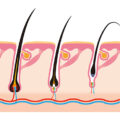Last updated on June 3, 2024
A well-executed hair transplant is not just a medical procedure; it is a work of art. Central to this artistry is the design of a natural hairline. Crafting a hairline that seamlessly blends with an individual’s features requires precision, skill, and a deep understanding of facial anatomy. In this blog, we will explore the intricacies of designing a natural hairline and how it can make a world of difference in the outcome of a hair transplant.
The Importance of a Natural Hairline
The hairline is the most visible part of hair transplants. A natural-looking hairline is essential for a harmonious and balanced facial appearance. It not only frames the face but also contributes significantly to one’s overall aesthetic.
Facial Anatomy and Symmetry
Before the procedure begins, a skilled doctor assesses the patient’s facial features, taking into account factors such as forehead shape, brow position, and overall facial proportions. This analysis guides the design of the hairline to ensure it complements the individual’s unique characteristics.
The Angle and Direction of Hair Growth
To achieve a natural look, the angle and direction of transplanted hair follicles must mimic the natural growth pattern. This meticulous attention to detail is what sets apart a skilled doctor from a novice.
Gradation and Density
A natural hairline is not a sharp, distinct line; rather, it’s a gradual transition from the forehead to the hair-covered scalp. Achieving this seamless gradation requires careful placement of follicles with varying densities.
Age-Appropriate Hairlines
Designing a hairline isn’t a one-size-fits-all endeavor. It should take into consideration the patient’s age, as age affects hairline placement. For example, a lower hairline may be suitable for a younger individual, while a slightly receded hairline may be more appropriate for an older patient.
Ethnic Considerations
Different ethnicities have unique hairline characteristics. A skilled doctor understands these distinctions and tailors the hairline design to suit the patient’s specific ethnic background, ensuring a natural and culturally appropriate outcome.
Patient Collaboration
A successful hair transplant is a collaborative effort between the patient and the doctor. Effective communication and a thorough understanding of the patient’s expectations are crucial in achieving the desired results.
Post-Operative Care and Styling Tips
After the transplant, the patient receives guidance on how to care for the newly transplanted hair and style it for the most natural appearance. This includes recommendations on shampoos, styling products, and techniques.
Conclusion
Designing a natural hairline is at the heart of a successful hair transplant. It requires a blend of medical expertise and artistic sensibility. A skilled doctor takes into account facial anatomy, hair growth patterns, and individual characteristics to create a hairline that seamlessly integrates with the patient’s appearance.
At our clinic, we understand the artistry behind hair transplants and are committed to providing results that not only restore hair but also enhance confidence and self-esteem. If you’re considering a hair transplant, trust in our expertise to craft a hairline that reflects the true you.
Contact us today to schedule a consultation and embark on your journey to a natural, fuller head of hair.








